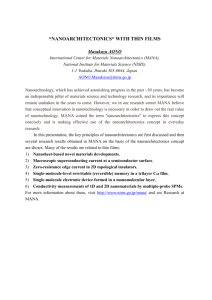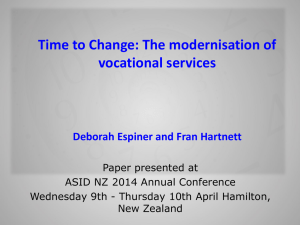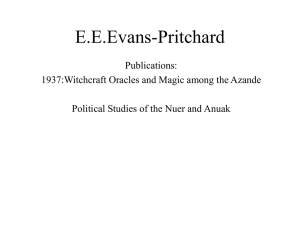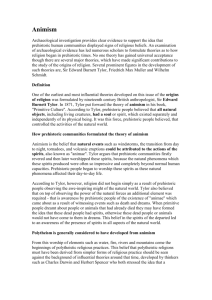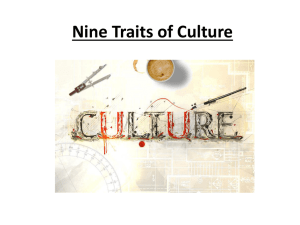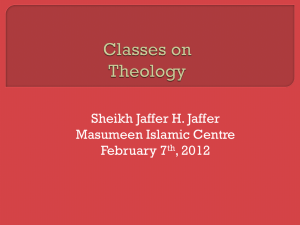A Drought in Bima PPT
advertisement
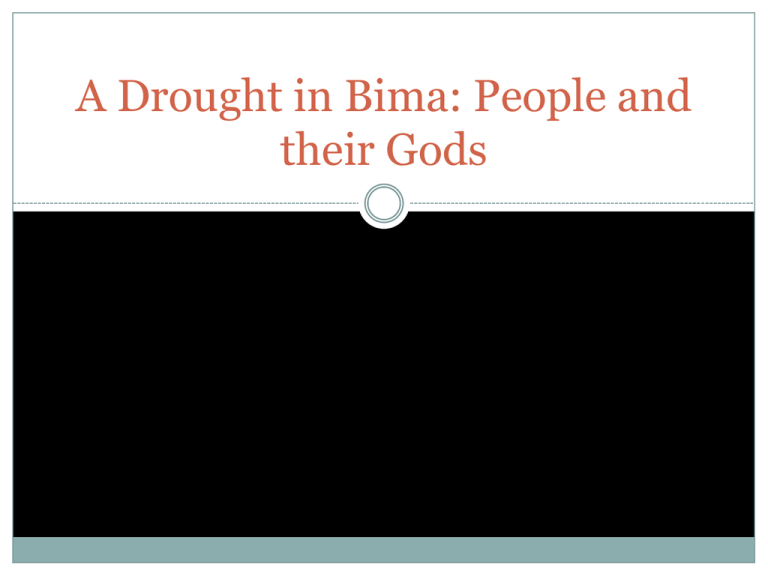
A Drought in Bima: People and their Gods Caves of Lascaux… LASCAUX... Animism The founder of the anthropology of religion was Sir E.B. Tylor Religion was born as people tried to understand conditions and events they could not explain by reference to daily experience. Tylor believed that our ancestors– and contemporary nonindustrial peoples-were particularly intrigued with death, dreaming, and trance. In dreams and trances, people see images they may remember when they wake up or come out of the trance state. Tylor concluded that attempts to explain dreams and trances led early humans to believe that two entities inhabit the body: one active during the day and the other-a double or soul- active during sleep and trance states. Although they never meet, they are vital to each other. When the double permanently leaves the body, the person dies. Death is departure of the soul. From the Latin for soul, anima, Tylor named this belief animism. The soul was one sort of spiritual entity; people remembered various images from their dreams and trances-other spirits. For Tylor, animism, the earliest form of religion, was a belief in spiritual beings. Tylor proposed that religion evolved through stages, beginning with animism, then polytheism (the belief in multiple gods) and then monotheism (the belief in a single, all-powerful deity) developed later. Because religion originated to explain things people didn't understand, Tylor thought it would decline as science offered better explanations. To an extent, he was right. We now have scientific explanations for many things that religion once dealt with. Nevertheless, because religion persists, it must do something more than explain the mysterious. Mana… …a view of the supernatural as a domain of raw impersonal power, or force, that people can control under certain conditions. Such a conception of the supernatural is particularly prominent in Melanesia. Melanesians believed in mana, a sacred impersonal force existing in the universe. Mana can reside in people, animals, plants, and objects. Melanesian mana was similar to our notion of efficacy or luck. Melanesians attributed success to mana, which people could acquire or manipulate in different ways, such as through magic. Objects with mana could change someone's luck. For example, a charm or amulet belonging to a successful hunter might transmit the hunter's mana to the next person who held or wore it. A woman might put a rock in her garden, see her yields improve dramatically, and attribute the change to the force contained in the rock. The Drought… Reactions of the two groups, the Dou Donggo and the Bimanese to drought… Bimanese, as followers of Islam, declared a day of fasting and prayer and gathered in the Grand Mosque to beseech Allah to to give them rain Dou Donggo, elders and ritual specialists went into the bush to a particular stream, cleaned debris from the mouth of the stream and left offerings of rice wine, rice, betel, tobacco and a sacrificed chicken. For the Muslims, their response was to appeal to Allah, the all-powerful God. Human beings are dependent on God’s will, which in turn may depend on their behaviour. For the Dou Donggo, however, the rains are part of a natural order. Mischievous spirits, the remains of placentas discarded in the forest, interfere and interrupt the rains. They are ‘the part of us that did not become human’ and must be placated with offerings. Bimanese…Dou Donggo Bimanese had a semi-feudal society in which a Sultan owned all the land and in theory, all of the people. Relationship between ruler and ruled was very much like that of father and child. Dou Donggo society is egalitarian, subsistence is communal as land is owned by the villagers. Spirits who cause the trouble belong to, and come from them. Religion as practiced… Anthropological approach to religion has been to observe it being practiced. Religion is practiced through ritual behaviour. Durkheim-in religion one finds basic social categorizations and through cosmology people represent their society to themselves. Religious rituals are ‘society worshipping itself.” This creates intense personal communal experiences that confirm social solidarity. Arnold van Gennep –Les Rite de Passage (1908) van Gennep was a folklorist. He thought of society as a large house with many rooms, each room symbolizing a different social status. Rites of passage move people from one room to another, allowing them to shed an old status and acquire a new one. Through these transitions ceremonies are held which move participants from one status to the next. vanGennep recognized a common cross-cultural structure to these rituals. Separation- Transition- Re-incorporation- Victor Turner Symbolic Anthropology…early career as a structural- functionalist. Best known for his work on symbols, rituals and rites of passage. Expanded on vanGenneps three stages of rites of passage and further explored the separation stage of rituals. The separation or ‘liminal’ phase was called the ‘betwixt and between’ stage of the rite. This phase is the most interesting! From the Latin ‘limen’ meaning ‘threshold’ Liminality… ‘Betwixt and between’ --is the quality of ambiguity or disorientation that occurs in the middle stage of a rite of passage. During a ritual's liminal stage, participants "stand at the threshold" between their previous way of structuring their identity, time, or community, and a new way, which the ritual establishes. Liminal stage is the stage at which instruction is given to inform participants of their upcoming status. They are no longer constrained by their old status. Victor Turner…”From Ritual to Theatre”(1984) “An experience is itself a process that presses out to an expression that completes it.” The stage of liminality in a rite of passage is the creative stage in which participants are enabled to ‘play’ with the symbols of their culture. Existing symbols are manipulated into new forms or new symbols are created which give meaning to the new experience. He defined the liminal place as “a gap between the ordered worlds where almost anything could happen. ” Belief Systems… One thing religion or belief helps us to is deal with problems that are significant, persistent, and intolerable. Provides a set of ideas about how the world is put together that allows people to accommodate anxieties and deal with misfortune. Azande witchcraft – one way in which many traditional cultures deal with such things is through the belief in and use of witchcraft The Azande of Southern Sudan Among the Azande the belief in and use of witchcraft has been a major part of their culture. All misfortune is attributed to witchcraft. No death in Azande communities is without accusation of witchcraft. The example of the falling granary is made famous by Evans-Pritchard. The fact that the granary is weakened by termites is immaterial…what made the people who were injured sit there at that particular time? That is where the explanation of witchcraft provides an answer. As Monaghan and Just state, the notion that it was coincidence or chance is really no explanation at all! Religious Movements… What happens when societies must deal with change as has been the case for many in the recent past? Religious belief can be overwhelmed by experiences which are too monumental or life-changing. Millenary (Millenarianism) movements - the belief by a religious, social, or political group or movement in a coming major transformation of society. Cargo Cults – religious practice that has appeared in many traditional pre-industrial tribal societies in the wake of interaction with technologically advanced cultures. Examples come mainly from Micronesia: John Frum cult and the Prince Phillip cult, both from Tanna, Vanuatu. Wikipedia Cargo... In Melanesia, the sudden arrival of unimaginably wealthy and technologically advanced soldiers during World War II, and then their equally sudden disappearance at its end, produced tremendous psychological upheaval for the technologically simple peoples of the interior. (pg. 126) Movements arise in order to accommodate for the dislocations of these experiences.

